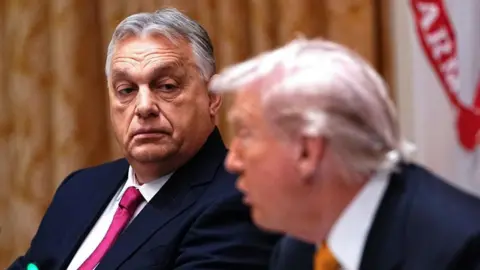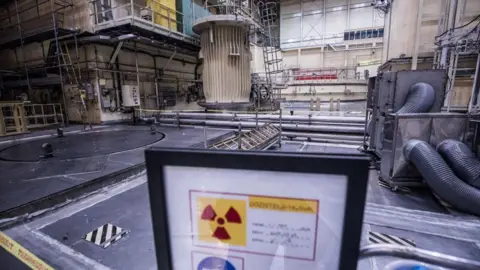Nick thorpeBudapest, Hungary
 EPA / SHUTTERSTOCK
EPA / SHUTTERSTOCKOn the surface, the Hungarian Prime Minister’s trip is exactly what he went to Washington for: lavish praise and an exemption from Russian oil, gas and nuclear sanctions.
And all that is only five months from a difficult election.
Think closer, though, and the picture isn’t so clear cut. The US side struck a tough trade deal – and a costly one for Hungary.
And there is no progress in Viktor Orban’s biggest headache: the end of the war in neighboring Ukraine, and with it the shadow of the shadow facing Hungary.
Let’s look first at the key victory of ORAN – A Annual Exemption from US sanctions.
The length of time is interesting. Trump clearly wants to help his friend win the April election. And the exemption is even partially related to the demand of the European Commission to all member states to end the import of Russian oil, gas and nuclear fuel by the end of 2027.
What is missing, from an EU perspective, is any political commitment from Oban to meet the demand – a commitment that the Czech government has made and fulfilled. And the EU intends to tie energy sanctions – to the brutality of Hungary and Slovakia.
Away from the media spotlight, the MOUNG Energy Company MOL upgraded two of its refineries – Százhalombatta in Hungary and the Slovnaft Facility Instead of urals pipes flowing in russ pipes.
On Friday, Mol said that 80% of its oil needs will be imported through the adrination pipeline from Croatia, even with higher logistics costs.
That’s why Oban’s argument, which is interesting to Trump, that Hungary, as a landlocked country, has no substitute for Russian oil is simply not true.
In total, Hungary and Slovakia together pay Russia $13BN (£10bn) for the entire invasion of Ukraine in February 2022 and the end of 2024.
The one-year window provided by the US is nevertheless a valuable respite for Hungarian households this winter.
Orban told pro-government reporters traveling with him to Washington that otherwise utility bills “could come up to three times in December”. Wrapping up bills in different ways has been a central plank of his popularity in Hungary since 2013.
Under the example of the US, Hungary can also continue to buy Russian gas through the Turkstream Pipeline, which blocks the Balkans, and pay for hard money ($185m in August alone) using a Bulgariian Loophole. Orban agreed to buy LNG from the US worth $600 million, according to Bloomberg.
Another key part of the Washington Deal is nuclear.
Hungary agreed to buy nuclear fuel rods for the Paks Paker 1 Nuclear Power Station (in the amount purchased from Rosatom and France’s Rosatome’s Framatome.
The Russian plan to finance and build the nuclear extension, called Paks 2, has long been delayed by technical and licensing issues. The US Agreement to lift all nuclear sanctions on Hungary may help open up the project, but thorny problems remain.
Hungary also agreed to buy US technology to expand the short-term muctent fuel of the Paks between $ 100m.
 Akos Stiller/Bloomberg via getty images
Akos Stiller/Bloomberg via getty imagesPerhaps the biggest part of the agreement is a Hungarian commitment to buy up to 10 small modular nuclear reactors from the US, for somewhere between $10BN and $20BN.
Hungwary needs electricity to power the many Chinese battery plants being built across the country. Smaller nuclear plants are less plagued by construction delays, and easier to license.
Finally, a cash withdrawal deal – same as a new one The US-Argentina deal with the PESO – under it and Hungarian Central banks can exchange the currency in question.
This means that in the future financial crisis in Hungary, the US Central Bank can feed Hungarian dollars.
So in summary, Hungary struck a deal to buy US gas, nuclear energy and unknown weapons systems in exchange for oil and gas.
But it failed to obtain the renewal of the US Visda Waiver system, eliminated in 2022, which undermines mutual trade. And a new date has not been set for a potential Trump-Putin summit in Budapest as part of efforts to end the Russia-Ukraine War.
Critics say Russia’s energy dependence is being replaced by US energy dependence. The Oban government has argued that greater diversity of supply has been achieved.


